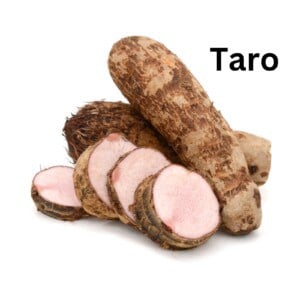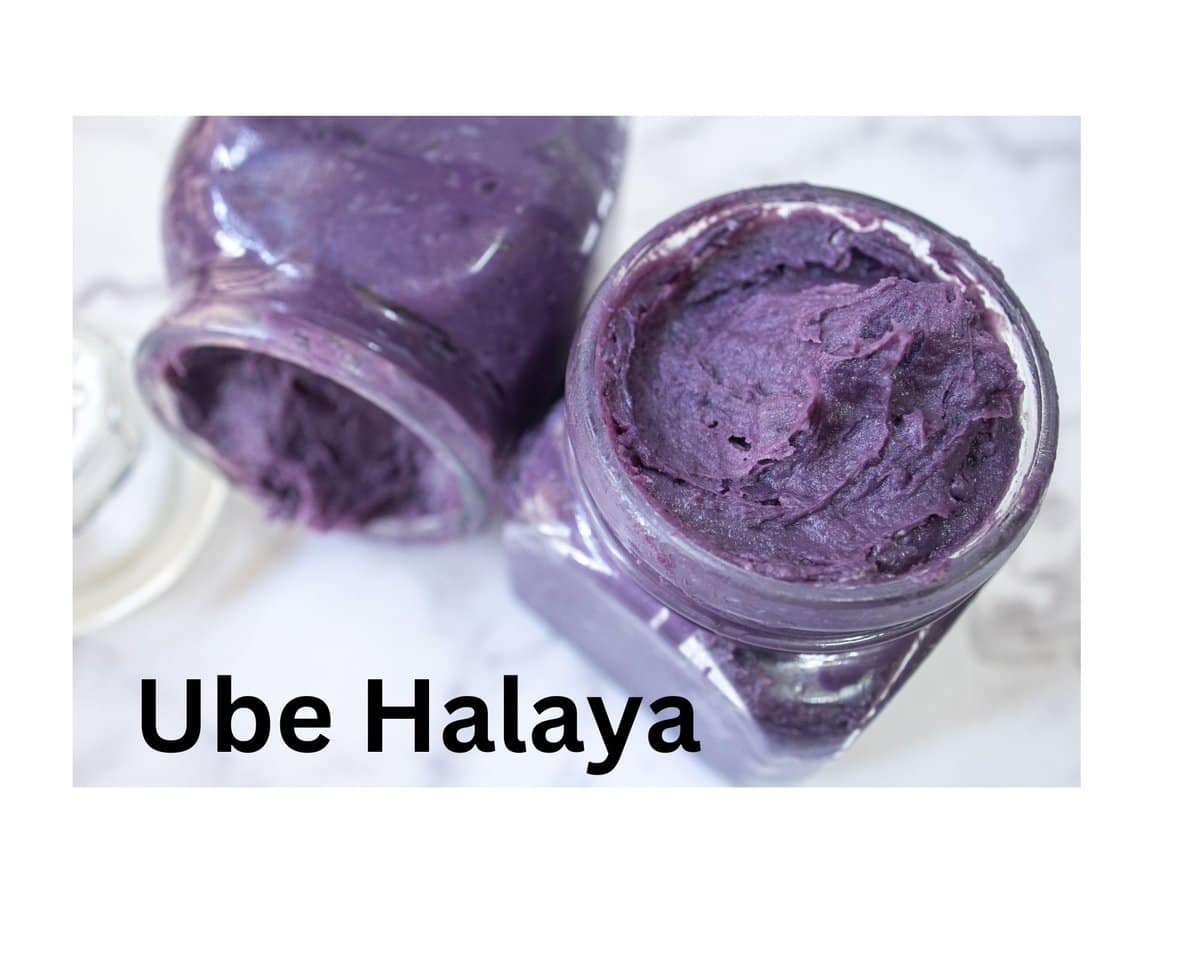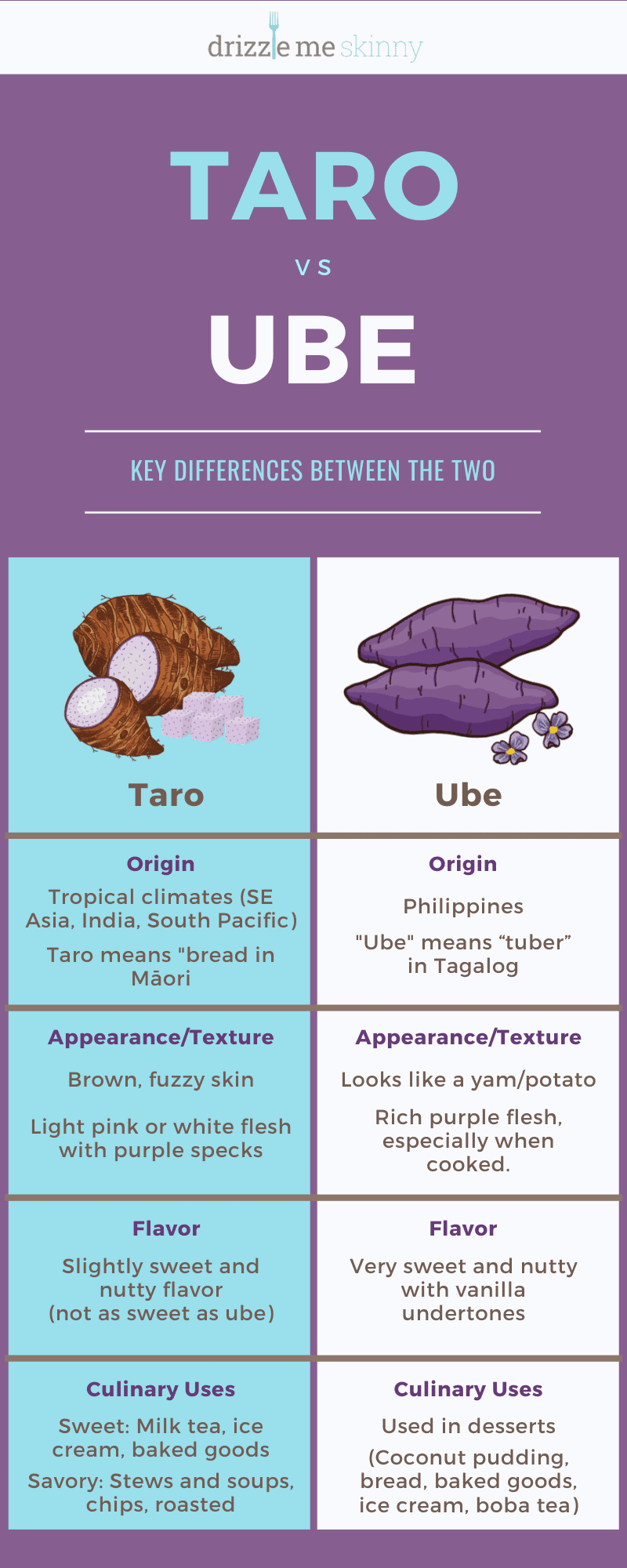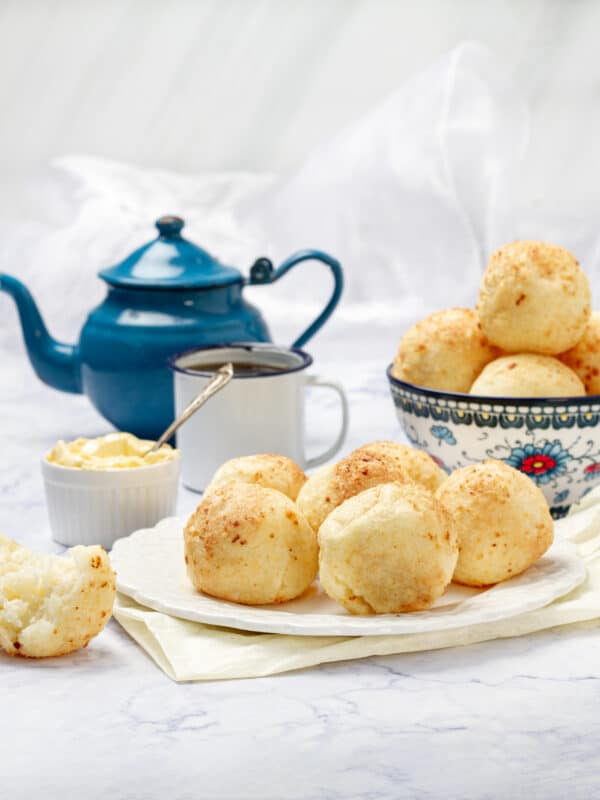If you’ve ever ordered a boba or milk tea, odds are you’ve heard of ube and taro. Both of these beautifully-hued root vegetables are related to the sweet potato, and their starchy flesh is used in both desserts and savory dishes in regions where they grow.
If you’ve never heard of these veggies or simply don’t know much about them, this is the article for you! Let’s compare the ube and taro tubers and get down to the root of what they are, where they come from, and how they’re used.
What is ube?
The word “Ube” means “tuber” in Tagalog, the main language of the Philippines, where this root vegetable hails from. Also known as “purple yam,” ube is said to have been used by people in Asia since ancient times.
This root has many health benefits. It’s a great source of fiber, antioxidants, carbohydrates, potassium, and vitamin C and helps support a healthy gut microbiome. Ube may also help prevent diabetes by stabilizing blood sugar.
Appearance and texture of ube
The ube is called a purple yam for good reason—it looks strikingly like a purple sweet potato and has a rich color, particularly in the flesh. The ube gets even darker and more vibrant as it’s cooked.
In terms of texture, ube has more moisture than potatoes or taro and the flesh is nice and creamy when cooked.
What is ube flavor?
The flavor of ube is sweet with nutty, vanilla undertones. The sweetness is not overpowering, but it is significantly sweeter than taro. Some say it is reminiscent of white chocolate or pistachio. Ube flavor pairs perfectly with coconut milk and flesh, which is why it’s often used to make desserts in Southeast Asia.
Culinary uses of ube
In the United States, ube is most popularly used in boba tea and to flavor ice cream. In Filipino cuisine, ube is most often boiled and mashed with condensed milk and turned into sweet treats, like jam or coconut ube pudding. The purple tuber is also used to color bread, cakes, and other baked goods.
Ube can also be cooked and eaten like a yam—steamed, roasted, boiled, or mashed—though it’s most commonly used in desserts because it’s so sweet.
Looking for recipes using ube?
Check out this roundup of 17 delicious ube recipes from Insanely Good! From creamy, no-churn ice cream to purple doughnuts, cupcakes, and pancakes, you’re sure to find something to satisfy your sweet tooth AND provide you with a food photo op!
What is taro?
Taro, or Colocasia esculenta, is a tuber that originated in Southeast Asia and is also commonly found in India and other tropical regions, such as Hawaii and Australia. Taro is used in many cuisines across Africa, India, and the South Pacific Islands.
Interestingly, the name taro is a Māori word literally meaning “bread.” It is thought to be one of the earliest domesticated crops enjoyed by humans. Taro is a heart-healthy and fiber-rich food that may help regulate blood sugar, blood pressure, and cholesterol.
Appearance and texture of taro
Taro actually looks quite different from ube, even though they are both tubers and are often confused by those unfamiliar with these tropical ingredients. Taro has a brown and fuzzy exterior with pale pink or white flesh on the inside. The flesh has specks of purple color.
Taro has a starchy, potato-like flesh. Depending on how you cook taro, it can be quite soft and smooth, almost like a custard, or crispy like a chip. It’s not as creamy as ube as it doesn’t have as much moisture.
What does taro taste like?
Like ube, taro has a starchy, nutty flavor with a hint of vanilla. It is subtly sweet, but not as sweet as ube. The flavor can lean more toward the sweeter or savory side, depending on how it’s prepared.
Culinary uses of taro
Taro is used in both savory dishes and desserts and is prepared differently depending on the region. Some common uses of taro roots are taro boba or milk tea, taro chips, buns, bread, cakes, and ice cream. Taro can also be cooked any way that a potato is.
In East Africa, where it’s called dasheen, taro is commonly cooked into soups and stews. There, they also use the leaves, which look like elephants’ ears.
WARNING: Both the flesh and the leaves of the taro plant are toxic and are considered dangerous to eat raw. It’s recommended to use gloves when handling raw taro and cook the vegetable properly to avoid illness.
Looking for recipes using taro?
For 21 sweet and savory taro root recipes, be sure to take a look at this recipe roundup from Yummy Addiction. The recipes use a mix of taro powders, flesh, and paste and include tips on how to prepare the vegetable safely. Enjoy!
Summary: What is the difference between taro vs ube?
Both taro and ube are starchy tubers with purple hues, and they are commonly used in milk teas, desserts, and savory dishes around the world. However, they have some notable differences that separate the two.
- Origin: Ube is from the Philippines while taro is grown in many tropical regions, including Asia, India, and the South Pacific.
- Appearance: Ube looks like a purple yam with dark purple flesh. Taro has brown fuzzy skin with light-colored flesh and purple specks inside
- Taste: Both are subtly sweet with nutty, vanilla undertones. Ube is sweeter than taro.
- Culinary uses: Ube is usually used in desserts. Taro is used in both desserts and savory dishes.
Related Recipes
Has reading this made you hungry for something sweet? Take a look at my roundup of the 29 Best Weight Watchers desserts! These lightened-up recipes are easy and delicious, and there’s something for everyone!
If starchy potatoes are what you’re in the mood for, here are 25 of the best russet potato recipes to try!
Frequently Asked Questions (FAQs)
Is ube sweeter than taro?
Yes, ube is much sweeter than taro. This is why ube is generally used to make desserts, while taro can be used in sweet treats or savory dishes.
Is taro just purple sweet potato?
Though often called “purple yam,” taro, sweet potato, and yam are different plant species with distinct textures, flavors, and nutritional profiles.
Is ube or taro boba better?
Both ube and taro make a great boba tea, especially when paired with coconut. Ube is sweeter than taro, so if you have a real sweet tooth, you might prefer ube.
Taro vs Ube

Instructions
- Select Your favorite recipe collection
- Click the link to view the recipes.
- Follow the linked instructions.
- Enjoy!








